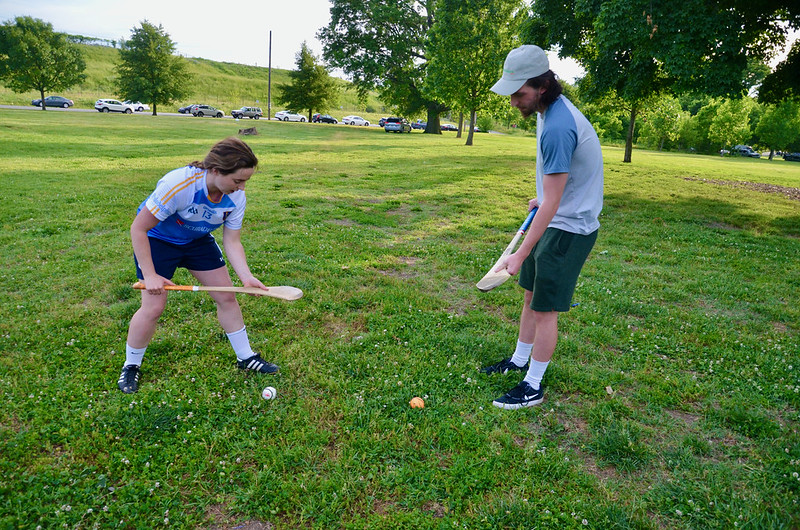It’s a little like lacrosse, a bit like field hockey, and even has a smidgeon in common with baseball. It’s ancient, it’s Irish, and it’s one of the fastest-moving games—and at times incredibly physical—in all of sports.
It’s called hurling. I arrived at Mander Playground in Fairmount Park one warm spring night to learn what I could about the game.
Out on the field, about 20 members of the Philly team, Na Toraidhe—Irish Gaelic for “the pursuers”—are running back and forth in organized drills. They’re smacking a small ball called a “sliotar”—about the size of an American baseball—with flat-bladed bats called “hurleys.” They’re tossing the ball back and forth to each other. They’re almost effortlessly picking up the ball with the front edges of their hurleys.
Players can catch and throw the ball or hit it out of the air or off the ground. The aim is to hit the ball into a field hockey-like net or between uprights, similar to those in American football, placed on either side of the net. Getting the ball in the net is worth three points; through the uprights, one.
There is very little protective gear worn, which is surprising to me once I see how fast the ball moves. Getting hit by a sliotar would certainly sting quite a bit. Although the game in some form or another dates back centuries, amazingly, protective helmets have been required only since 2010.
To learn more, I met up with Tara Chadwick, one of the leaders of Na Toraidhe, also known as the Philadelphia Hurling and Camogie Club. She is a native of Ireland who has been playing the female equivalent of hurling—it’s called camogie—since she was 8. “There are slight differences between hurling and camogie. In Ireland this season they’ve introduced new rules for the camogie to make it more like the guys” Chadwick explains. “Hurling has more physicality than camogie. They can do more shouldering and jostling than the girls’ game. In camogie you could hand pass the sliotar into the net whereas guys have to use the hurley to hit it in.”
Handing me a hurley and a sliotar, Chadwick offered me a brief introductory lesson.
She started off by teaching me how to perform a roll lift. This move is used to get the sliotar off the ground and into the player’s hand while stationary. After a few tries, I am able to pick the ball up fairly easily, but the next move is more challenging.
It’s called the jab lift. This is typically used when a player is in motion, and the goal is to get it into the player’s hands. A player can carry the ball in their hands for up to four steps, then either has to make a pass or hit the sliotar with the hurley. The added motion in the jab lift makes it more difficult to learn than the roll lift.
Although I am still not an expert at handling the hurley, Chadwick offers me words of encouragement.
All of this is enough standing on the sidelines; it’s harder out on the field. That’s just fine with Patrick Rooney, Jr., a newcomer to the sport—he’s only been on the team three weeks. Although he’s only just begun playing, his parents are from Ireland and his father owns Paddy Rooney’s Pub in Havertown where they show the Gaelic games every year, so he’s been watching hurling for as long as he can remember.
“It’s a great sport,” he says. “I’ve watched it my entire life and I played Gaelic football my entire life so there’s a lot of similarities between the two. A lot of the positioning, movement, and the physical nature of the games are kind of similar so it’s been great to start playing. Compared to other Gaelic games, hurling is the sport that kind of makes people go ‘Wow, what is this?’ The game really sells itself to people in terms of how fast paced and exciting it is.”
Going purely by his heritage, you might argue, Rooney should only be playing Gaelic football instead of answering the siren song of hurling.
“I come from a Gaelic football family,” he says. “Both my parents were from in Ireland. My father’s family is from County Down and my mother’s family is from Cavan and those were generally heavy football counties. Down south and especially toward the West Coast they’d be super into hurling. There are some football powerhouses down there. Up north it’s almost only football, but recently hurling has gotten more popular.”
Hurling also seems to be growing more popular in this area as well, and it is easy to see why. The game moves incredibly fast but is also accessible to many people and requires little equipment. There is also a great social aspect to the hurling club. “They do such a good job of selling it as a hurling and camogie club absolutely, but they do so well on other aspects where it’s like a social club as well with all kinds of events. It gives you a great physical activity to do and you can make new friends and new connections,” says Rooney.
Na Toraidhe is the only hurling club in Philadelphia and so they often have to travel to find competition. They end up playing teams from New York, D.C., and Virginia. Na Toraidhe will automatically qualify for the national tournament this year and head up to Boston to compete. They have had recent success in competition. Two years ago, the men actually won the junior title at Nationals.
The club provides a very welcoming and social environment to anyone interested in the sport. They practice Tuesday and Thursday nights at Mander Playground. For details on how to join, contact the club at natoraidhe@gmail.com.

